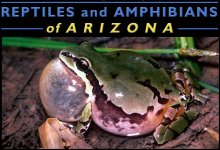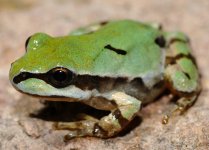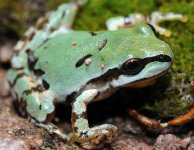| Range: |
 |
| Other Names: |
Mountain Treefrog |
| Description: |
The Arizona Treefrog is a relatively small (to 2.25 inches) green or coppery brown frog with a dark eyestripe that extends past the shoulder onto the side of the body, and sometimes to the groin area. This dark stripe may break into spots or dashes past the shoulder. The eyestripe on the similar Pacific treefrog does not extend past the shoulder. Some individuals exhibit dark spots on the head and upper back, and bars or spots on the lower back. The throat of the male is dusky green or tan, and males average a slightly smaller size than females. Larger tadpoles are golden-brown above and below with tails mottled black. They grow to about 1.5 inches. |
| Habitat: |
The Arizona Treefrog is a species of montane streams, wet meadows, cienegas, roadside ditches, and livestock tanks in oak, pine-oak, pondersosa pine, Douglas fir, and other forest types, mostly above 5,000 feet. They breed most commonly in temporary waters, which support relatively few aquatic predators. |
| Behavior: |
Habits outside the breeding season are poorly known; however, non-breeding frogs can climb high into the trees or may be found on the ground in wet meadows or other damp places. A wintering frog was collected from a debris pile in January near Christopher Creek. |
| Hibernation: |
|
| Reproduction: |
Arizona Treefrogs breed at the beginning of the summer monsoon season. Breeding choruses typically last for only 2-3 days, after which most frogs leave the breeding habitats. However, occasional calling frogs can be heard through the summer. At the beginning of the monsoons, these frogs have been heard calling from the treetops. The call is a metallic clink, repeated 1-3 times per second. Eggs are laid in small clusters attached to vegetation. Tadpoles metamorphose in about 6-11 weeks. |
| Diet: |
Arizona Treefrogs have been found to feed on beetles, spiders, earthworms, flies, and bark beetles. They likely feed on a variety of other small invertebrates, as well. |
Adapted from account on reptilesofaz.org
Sources:


|

















